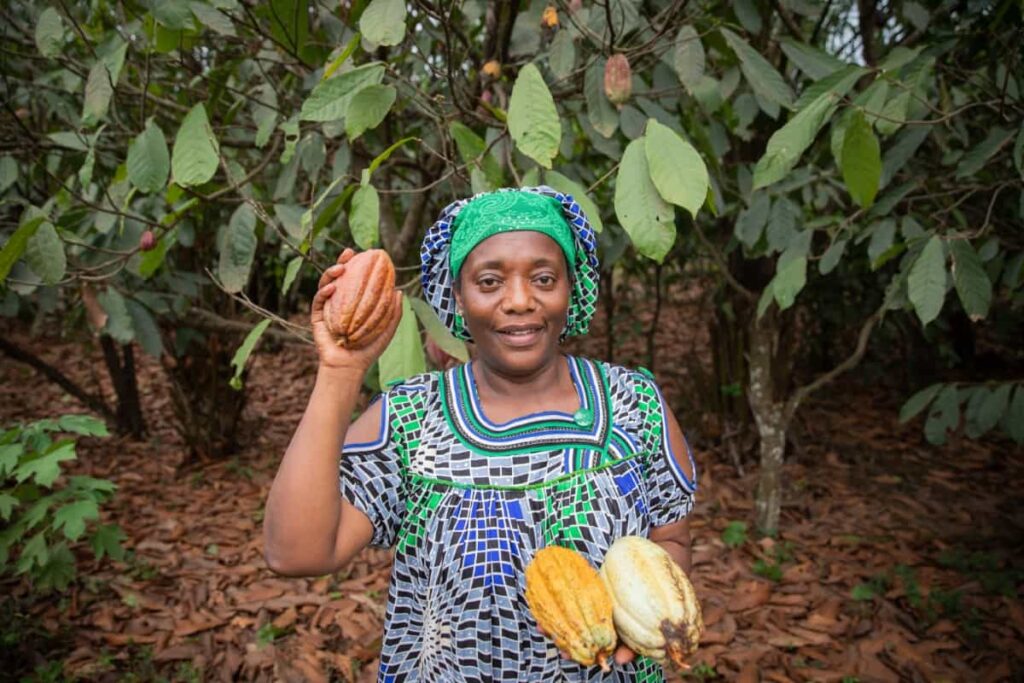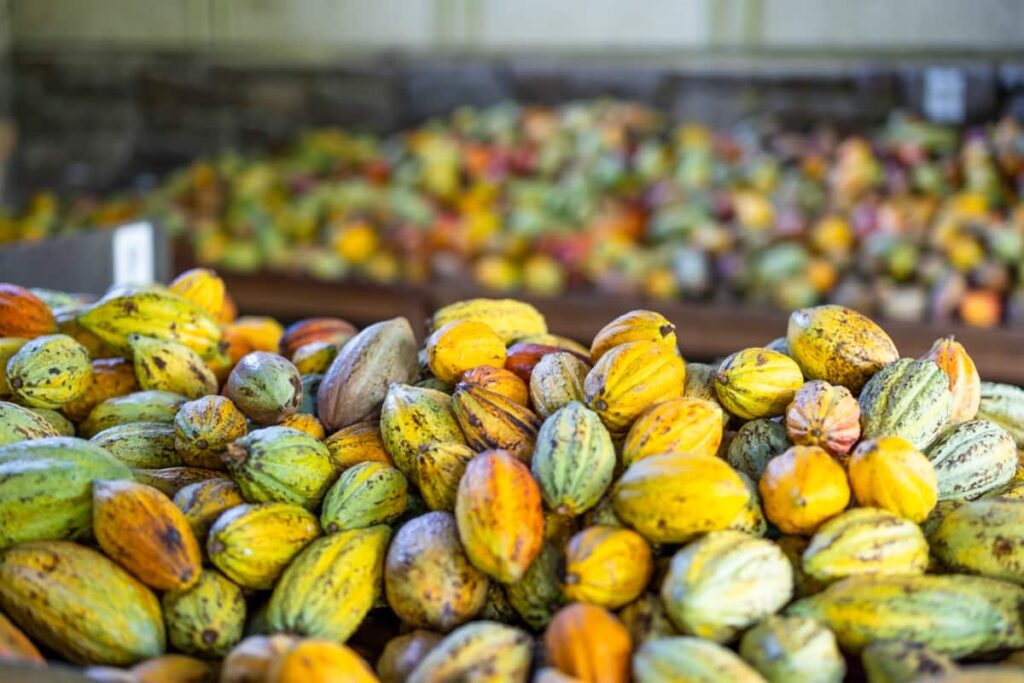Cocoa farming in Africa offers a multitude of benefits, making it a profitable venture for farmers and investors alike. Cocoa ((Theobroma cacao L.) is a high-value cash crop that provides significant economic opportunities. The demand for Cocoa products continues to rise globally, ensuring a stable market for African farmers.

Cocoa Farming in Africa
Overview of the Cocoa Farming Industry in Africa
The Cocoa farming industry in Africa holds immense significance and potential. With its favorable climate and fertile soil, the continent has become a major player in the global Cocoa market. Africa is responsible for producing over 70% of the world’s Cocoa beans, making it an essential region for chocolate manufacturers worldwide.
This dominance can be attributed to many factors, such as suitable growing conditions, traditional cultivation practices, and a long history of expertise in Cocoa production. Cocoa farming in Africa follows specific cultivation practices that have been passed down through generations. Recognizing the importance of sustainable agriculture, initiatives promoting environmentally friendly Cocoa farming have gained momentum across Africa.
African Cocoa Cultivation Practices
The main aspect of Cocoa farming in Africa is the careful selection and nurturing of Cocoa seedlings. Farmers meticulously choose high-quality seedlings that are resistant to diseases and pests prevalent in their specific region. To support healthy development, irrigation systems are often put in place to provide regular water supply during dry seasons. Fertilizers and pesticides are used responsibly, with an emphasis on organic alternatives whenever possible, to minimize environmental impact.
Regular maintenance activities such as weeding, pruning, and fertilizing help keep the Cocoa trees strong and productive. Harvesting typically takes place when the pods turn bright yellow or orange, indicating ripeness. Skilled laborers carefully cut each pod from the tree using sharp tools without damaging surrounding branches or fruits. Transporting harvested Cocoa beans from farms to processing facilities can be challenging due to poor infrastructure in some regions.
Cocoa Varieties Grown in the African Continent
When it comes to Cocoa farming, Africa is a treasure trove of diverse and unique Cocoa varieties. Each region within the continent boasts distinct flavor profiles and characteristics that make their Cocoa truly special. In West Africa, specifically Ivory Coast and Ghana, you will find the renowned Forastero variety. Known for its robust flavors and high yield, this variety makes up a significant portion of global Cocoa production.
In case you missed it: Beekeeping in South Africa: Requirements, License, Cost, and Training to Start

Moving further south, countries like Cameroon and Nigeria cultivate Trinitario Cocoa. This hybrid variety combines the best attributes of both Criollo and Forastero beans. Another important variety is Criollo Cocoa. Considered one of the finest varieties in the world, Criollo is known for its delicate flavor profile characterized by floral notes and low acidity levels.
Sustainable Cocoa Farming Initiatives in Africa
The major initiative is promoting agroforestry systems, which involve planting shade trees alongside Cocoa trees. These shade trees provide multiple benefits, including conserving soil moisture, preventing erosion, and creating habitats for beneficial insects. Another important aspect of sustainable Cocoa farming in Africa is implementing good agricultural practices (GAP). This includes proper land preparation techniques, integrated pest management strategies, efficient water management systems, and responsible use of fertilizers.
Cocoa Export and Trade in Africa
Africa is a major player in the global Cocoa export and trade market. Both small-scale farmers and large plantations characterize the Cocoa industry in Africa. Once the Cocoa beans are harvested, they go through a series of processes such as fermentation, drying, cleaning, grading, and packaging. In terms of trade, Africa exports a substantial amount of its cocoa products to countries like Europe (particularly Belgium), North America (the United States), and Asia (China).
These countries have a high demand for African Cocoa due to its unique flavor profile and superior quality. The economic impact of Cocoa exports on African countries cannot be understated. The revenue generated from exporting this agricultural commodity contributes significantly to foreign exchange earnings for many African nations.
Cocoa Yield in Africa
The amount of Cocoa that can be produced on a single acre of land can vary significantly, ranging from 1000 kilograms to 2000 kilograms. The crop yield is based on several factors like soil quality, climate conditions, cultivation practices, and farmer expertise.
Cocoa Farming Cost in Africa
When it comes to Cocoa farming, understanding the costs involved is crucial for farmers looking to maximize their profits. Remember that these values are estimates based on general industry averages; actual costs may vary depending on location-specific factors such as local labor rates and market conditions.
| Expense Category | Estimated Cost (USD) | Notes |
| Land Preparation Cost | 300 | Includes clearing, plowing, leveling |
| Seedlings Purchase | 200 | Cost of Cocoa seedlings per acre |
| Planting Cost | 200 | Labor costs for planting |
| Irrigation Cost | 200 | Setup and operational costs for irrigation |
| Fertilizers and Pesticides | 200 | Cost of fertilizers and pesticides |
| Labor for Maintenance | 400 | Regular weeding, fertilizing, and monitoring |
| Harvesting | 300 | Labor costs for harvesting |
| Transport and Marketing | 200 | Transporting produce and marketing expenses |
| Miscellaneous Cost | 100 | Contingency funds for unforeseen expenses |
Cocoa Cultivation Profit Analysis Per Acre
The profitability of Cocoa farming in Africa may change depending on factors such as climate conditions and farm management practices employed by individual farmers. However, the analysis serves as an encouraging indicator for those considering entering or expanding their involvement in the Cocoa farming industry in Africa.
| Revenue Category | Value | Notes |
| Total yield (kg) | 1500 | Estimated yield per acre |
| Average Market Price (USD/kg) | 2.2 | Estimated market price per kg |
| Gross Revenue (USD) | 3,300 | Total revenue from sales |
- Total Profit from 1-acre Cocoa Farming: Gross Revenue – Total Costs = 3,300 – 2100 = 1200 (USD)
- Overall, the profit potential makes Cocoa cultivation an attractive option for African farmers seeking economic stability and growth opportunities within their communities.
African Government Policies and Support for Cocoa Production
Many African countries have implemented policies and programs to support Cocoa farmers. These include providing subsidies for inputs such as fertilizers and pesticides, offering training and extension services to improve farming practices, and facilitating access to credit for small-scale farmers. In addition to these initiatives, some governments have established regulatory bodies to oversee the Cocoa sector, ensuring fair trade practices and quality control.
In case you missed it: How to Start Tomato Farming in Africa: Production Guide for South Africa, Egypt, Nigeria, Kenya, Ethiopia, and Zambia

They also work towards promoting sustainable farming methods that protect the environment while enhancing productivity. One example is Ghana’s Cocoa Board (COCOBOD), which implements various interventions aimed at improving Cocoa production. COCOBOD provides technical assistance, research funding, disease control measures, and market access support to farmers across the country.
Top 10 Cocoa Producing Countries in Africa
Ivory Coast: Known as the world’s leading producer of Cocoa, Ivory Coast contributes nearly 40% of global Cocoa production. The country’s favorable climate makes it an ideal location for Cocoa cultivation.
Ghana: With a long history of Cocoa farming, Ghana is the second-largest producer in Africa. The government has implemented various initiatives to support farmers and improve productivity.
Nigeria: Despite its vast potential, Nigeria currently ranks third in Cocoa production on the continent. However, recent efforts by the government and private sector aim to increase output and boost quality.
Cameroon: Renowned for its unique flavor profile, Cameroonian Cocoa is highly sought after by chocolate producers worldwide. The country employs sustainable farming practices and focuses on producing high-quality beans.
Côte d’Ivoire (Ivory Coast): This francophone West African nation shares borders with Liberia and Guinea-Bissau while also having close trade links with Mali and Burkina Faso through several economic communities such as ECOWAS or UEMOA (Cote d’Ivoire).
Togo: Despite being a relatively small country, Togo has made significant strides in the Cocoa industry over recent years. Its dedication to organic farming methods has garnered attention from international buyers.
Congo (DRC): Although political instability poses challenges in Congo’s agricultural sector, it still manages to produce a substantial amount of high-quality Cocoa beans each year.
Sierra Leone: Cocoa farming plays a vital role in Sierra Leone’s rural economy, providing income opportunities for many farmers across the country.
Uganda: Uganda may be better known for its coffee production; however, it is also emerging as a key player in the African Cocoa market due to suitable growing conditions and increased investment.
Equatorial Guinea: Although relatively small-scale compared to some neighboring nations, Equatorial Guinea holds promise with initiatives aimed at increasing its share in the global market.
Frequently Asked Questions (FAQ) on Cocoa Cultivation in Africa
Where is Cocoa Cultivation Primarily Found in Africa?
Cocoa cultivation thrives in the tropical regions of West Africa, with countries such as Ivory Coast, Ghana, Nigeria, and Cameroon being major producers. The favorable climate and rich soil provide the perfect conditions for Cocoa trees to flourish.
Is Cocoa Farming Sustainable?
Sustainable practices are crucial for the future of Cocoa farming in Africa and beyond. Many organizations work together with farmers to promote environmentally friendly methods like agroforestry and organic farming techniques while also ensuring fair wages and better living conditions for farmers.
How Important Is Cocoa to African Economies?
Cocoa production plays a vital role in many African economies by providing income and employment opportunities for countless farmers and workers.
In case you missed it: How to Start Vegetable Farming in South Africa: Commercial Business Plan, Cost, and Profit

Conclusion
Cocoa farming plays a crucial role in Africa’s agricultural sector and economy. Cocoa farming provides employment opportunities for thousands of people across various African countries. Cocoa cultivation practices in Africa encompass a wide range of techniques aimed at maximizing yields and ensuring the production of high-quality Cocoa beans. Farmers employ various methods to cultivate Cocoa trees, including careful land preparation, seedling purchase, planting, irrigation, and regular maintenance.
- Budget Friendly Sheep Shed Ideas: Cheap and Low-Cost Tips
- How Much Do Cattle Farmers Make: Revenue Streams in Cattle Farming
- Management Pests and Diseases in Your Cotton Field
- Sheep Farming Business Plan for Beginners
- Aquaponic Farming at Home: A Step-By-Step Guide
- Profitable Village Farming Business Ideas in 2024
- High-Yield Aquaculture: Fast-Growing Fish for Farming
- Effective Fish Pond Construction Techniques for Beginners
- Irrigation and Water Management in Pineapple Farming
